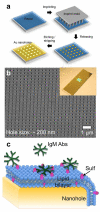High-affinity binding of remyelinating natural autoantibodies to myelin-mimicking lipid bilayers revealed by nanohole surface plasmon resonance
- PMID: 22762372
- PMCID: PMC3417152
- DOI: 10.1021/ac300819a
High-affinity binding of remyelinating natural autoantibodies to myelin-mimicking lipid bilayers revealed by nanohole surface plasmon resonance
Abstract
Multiple sclerosis is a progressive neurological disorder that results in the degradation of myelin sheaths that insulate axons in the central nervous system. Therefore promotion of myelin repair is a major thrust of multiple sclerosis treatment research. Two mouse monoclonal natural autoantibodies, O1 and O4, promote myelin repair in several mouse models of multiple sclerosis. Natural autoantibodies are generally polyreactive and predominantly of the IgM isotype. The prevailing paradigm is that because they are polyreactive, these antibodies bind antigens with low affinities. Despite their wide use in neuroscience and glial cell research, however, the affinities and kinetic constants of O1 and O4 antibodies have not been measured to date. In this work, we developed a membrane biosensing platform based on surface plasmon resonance in gold nanohole arrays with a series of surface modification techniques to form myelin-mimicking lipid bilayer membranes to measure both the association and dissociation rate constants for O1 and O4 antibodies binding to their myelin lipid antigens. The ratio of rate constants shows that O1 and O4 bind to galactocerebroside and sulfated galactocerebroside, respectively, with unusually small apparent dissociation constants (K(D) ≈ 0.9 nM) for natural autoantibodies. This is approximately one to 2 orders of magnitude lower than typically observed for the highest affinity natural autoantibodies. We propose that the unusually high affinity of O1 and O4 to their targets in myelin contributes to the mechanism by which they signal oligodendrocytes and induce central nervous system repair.
Figures





Similar articles
-
Surface Plasmon Resonance Sensing on Naturally Derived Membranes: A Remyelination-Promoting Human Antibody Binds Myelin with Extraordinary Affinity.Anal Chem. 2018 Nov 6;90(21):12567-12573. doi: 10.1021/acs.analchem.8b02664. Epub 2018 Oct 15. Anal Chem. 2018. PMID: 30231202
-
Method of identifying natural antibodies for remyelination.J Clin Immunol. 2010 May;30 Suppl 1(0 1):S50-5. doi: 10.1007/s10875-010-9406-5. J Clin Immunol. 2010. PMID: 20387101 Free PMC article.
-
Targeting of IgMkappa antibodies to oligodendrocytes promotes CNS remyelination.J Neurosci. 1998 Oct 1;18(19):7700-8. doi: 10.1523/JNEUROSCI.18-19-07700.1998. J Neurosci. 1998. PMID: 9742140 Free PMC article.
-
Invited article: human natural autoantibodies in the treatment of neurologic disease.Neurology. 2009 Apr 7;72(14):1269-76. doi: 10.1212/01.wnl.0000345662.05861.e4. Neurology. 2009. PMID: 19349608 Free PMC article. Review.
-
A unique population of circulating autoantibodies promotes central nervous system remyelination.Mult Scler. 1998 Jun;4(3):217-21. doi: 10.1177/135245859800400324. Mult Scler. 1998. PMID: 9762677 Review.
Cited by
-
Cellular targets and mechanistic strategies of remyelination-promoting IgMs as part of the naturally occurring autoantibody repertoire.Expert Rev Neurother. 2013 Sep;13(9):1017-29. doi: 10.1586/14737175.2013.835601. Expert Rev Neurother. 2013. PMID: 24053345 Free PMC article. Review.
-
Nanopore-induced spontaneous concentration for optofluidic sensing and particle assembly.Anal Chem. 2013 Jan 15;85(2):971-7. doi: 10.1021/ac302690w. Epub 2012 Dec 20. Anal Chem. 2013. PMID: 23214989 Free PMC article.
-
Probing the Interaction of Dielectric Nanoparticles with Supported Lipid Membrane Coatings on Nanoplasmonic Arrays.Sensors (Basel). 2017 Jun 23;17(7):1484. doi: 10.3390/s17071484. Sensors (Basel). 2017. PMID: 28644423 Free PMC article.
-
Surface Plasmon Resonance Study of the Binding of PEO-PPO-PEO Triblock Copolymer and PEO Homopolymer to Supported Lipid Bilayers.Langmuir. 2018 Jun 12;34(23):6703-6712. doi: 10.1021/acs.langmuir.8b00873. Epub 2018 Jun 1. Langmuir. 2018. PMID: 29787676 Free PMC article.
-
Transient infrared nanoscopy resolves the millisecond photoswitching dynamics of single lipid vesicles in water.Nat Commun. 2025 Jul 1;16(1):6033. doi: 10.1038/s41467-025-61341-9. Nat Commun. 2025. PMID: 40593745 Free PMC article.
References
-
- Noseworthy JH, Lucchinetti C, Rodriguez M, Weinshenker BG. New Engl. J. Med. 2000;343:938–952. - PubMed
-
- Anderson DW, Ellenberg JH, Leventhal CM, Reingold SC, Rodriguez M, Silberberg DH. Ann. Neurol. 1992;31:333–336. - PubMed
-
- Sommer I, Schachner M. Dev. Biol. 1981;83:311–327. - PubMed
-
- Bansal R, Warrington AE, Gard AL, Ranscht B, Pfeiffer SE. J. Neurosci. Res. 1989;24:548–557. - PubMed
Publication types
MeSH terms
Substances
Grants and funding
LinkOut - more resources
Full Text Sources

